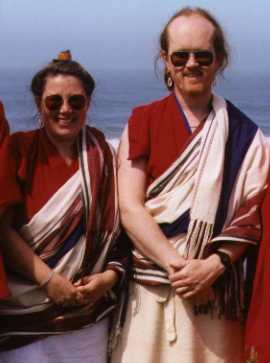
Ngala Nor’dzin & Ngala ’ö-Dzin
Teaching couples and the Aro gTér lineage
Ngala Nor’dzin Rang-jung Pamo & Ngala ’ö-Dzin Tridral Nyima ’ö-Zér Dorje are a ‘Lama teaching couple’ in the Confederate Sanghas of Aro. They live in the Bay Area of South Glamorgan – Cardiff, Wales and have two fine sons: Richard and Daniel. Here they wear the red, white, and blue striped shawls and the conch earrings of the gö-kar-chang-lo’i-dé (gos dKar lCang lo’i sDe). They wear the ngak’phang waistcoats and white shamthabs or yogic skirts. Ngala Nor’dzin Rang-jung Pamo wears the ivory archer’s ring in her hair which was presented to her by the Aro Tulku. The ivory ring is a type of takdröl, but it is rarely seen. Kyabjé Chhi’mèd Rig’dzin Rinpoche wore such an ivory ring on certain occasions, and within the Aro gTér lineage history it was worn by Gomchenma Naljorma Künzang Rang-rig Long-tsal (Khyungchen Aro Lingma requested Gomchenma Naljorma Künzang Rang-rig Long-tsal to make the naljorpa and naljorma vows available within the Aro Gar and thus the Aro gTér tradition). It is wonderful to have Ngala Nor’dzin & Ngala ’ö-Dzin as Lamas who form a teaching couple within the Confederate Sanghas of Aro.
Ngak’chang Rinpoche and Khandro Déchen said of them:
We
are extremely and unashamedly proud of Ngala Nor’dzin & Ngala ’ö-Dzin. They are wonderful people, wonderful parents, and utterly committed vow holders. They are a fine and solid example of how working family life can be successfully integrated with practice. The teaching couple is important within the Aro gTér lineage as a teaching method – in terms of the Khandro Pawo Nyi-da Mélong Gyüd. The relationship of the two Lamas has to be a teaching for their students in
terms of an evident display of love, trust, and respect – and in this Ngala Nor’dzin & Ngala ’ö-Dzin are highly successful teachers. We feel that it is vital to the establishment of Buddhism in the West that an alternative to celibacy and monasticism are established.
Ngakma Shardröl Wangmo
comments:
Buddhism will not be established
in the West as long as there are no ‘clergy’ apart from monastics. The main body
of celibates in the West are represented by the Catholic Church, and even they
are encountering increasing difficulties with celibacy as a religious form. Why,
in the light of celibacy being a controversial question within the major Western
religion that subscribes to its practice, do Buddhists pay heed to establishing
Buddhism as a celibate religion in the West? As Buddhist teachers and
practitioners, we actually have no interest in generating too pointed a critique
concerning celibacy – but we do wish to establish the gö-kar-chang-lo’i-dé as an
authentic, legitimate, and historically valid alternative.
